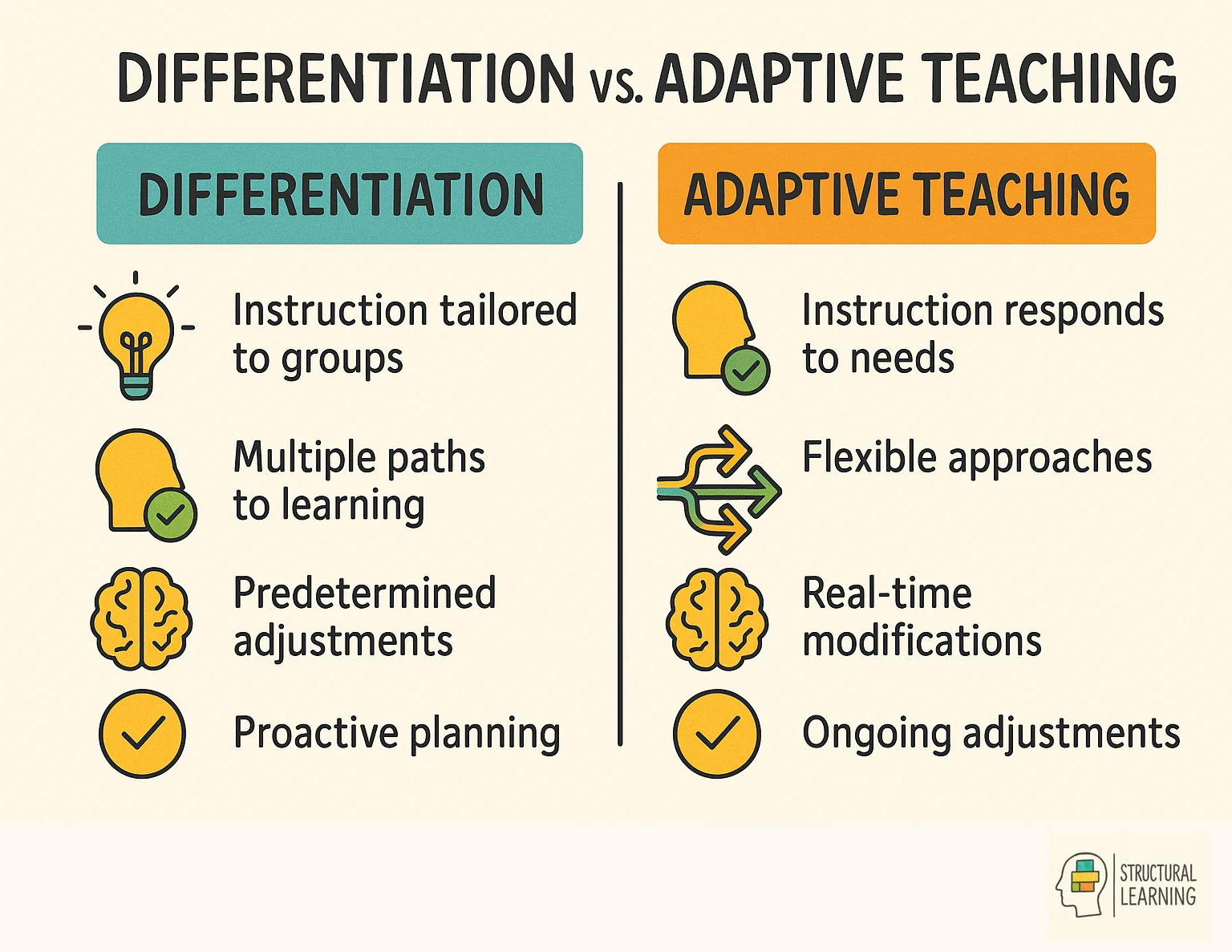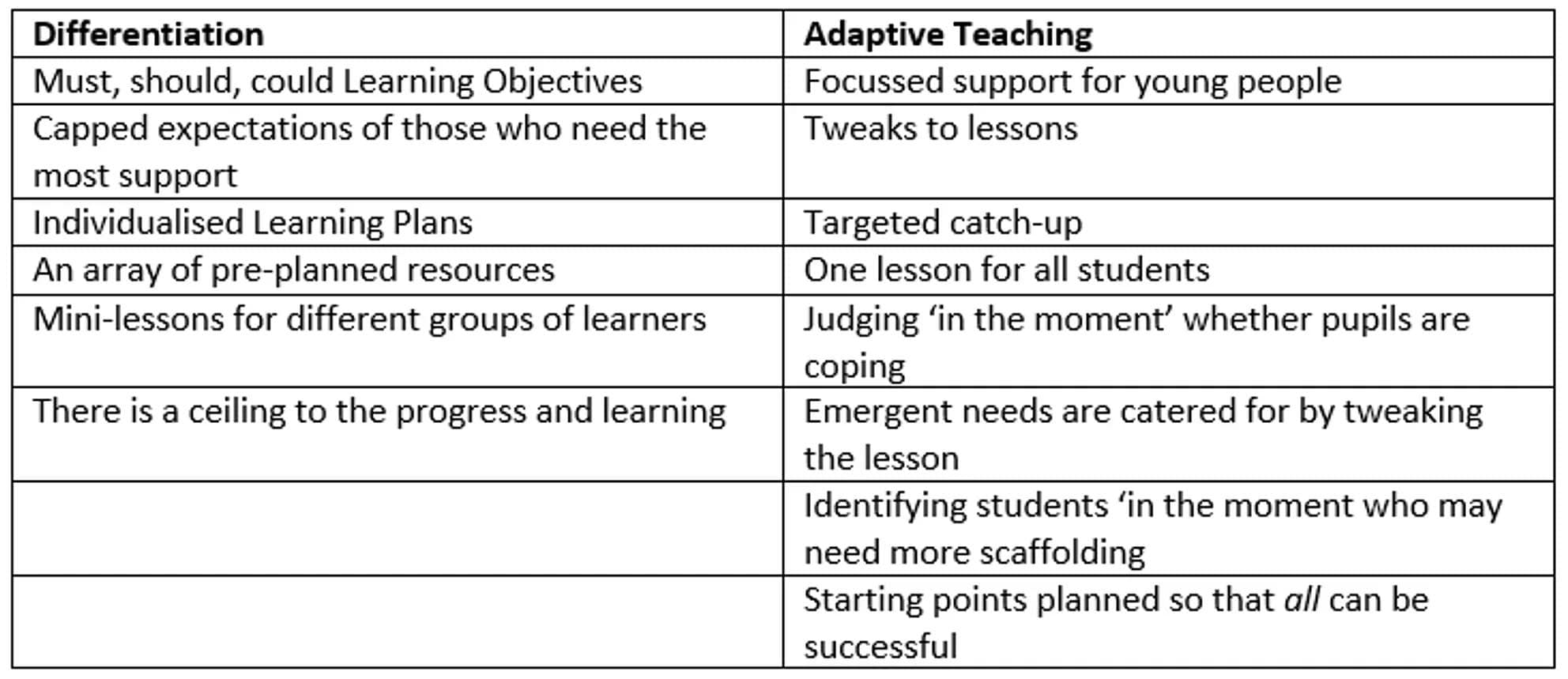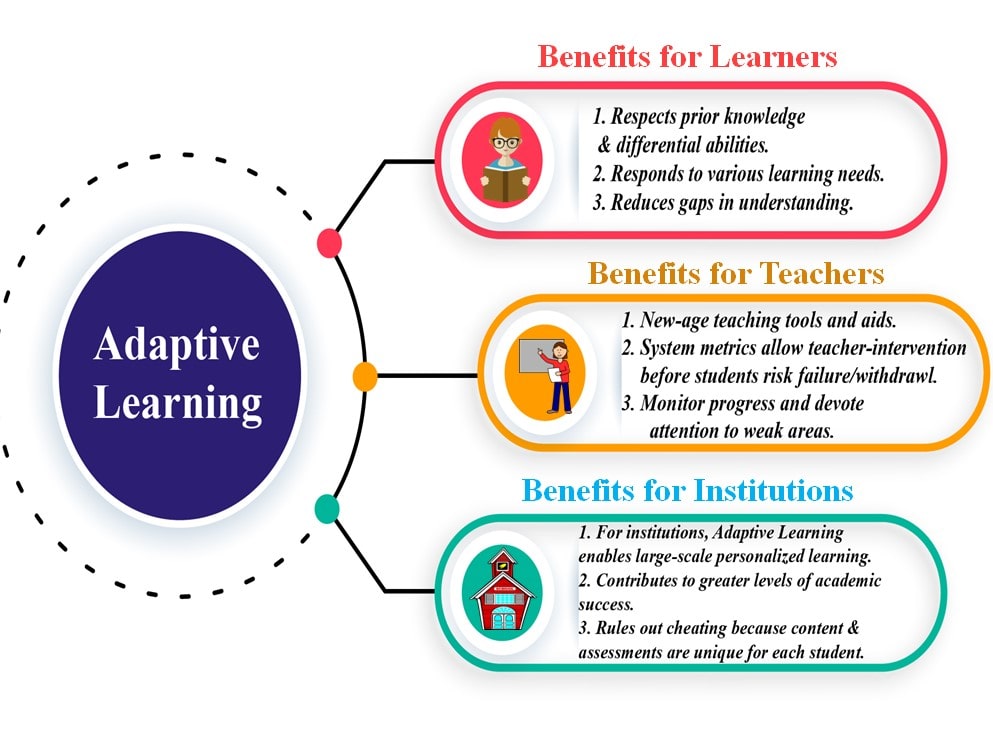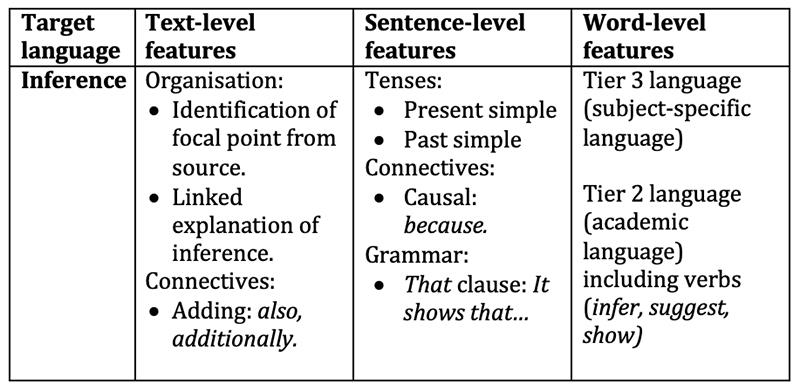Adaptive Teaching
Explore adaptive teaching strategies that personalize learning, meet diverse needs, and enhance student engagement in modern classrooms.


Explore adaptive teaching strategies that personalize learning, meet diverse needs, and enhance student engagement in modern classrooms.
Adaptive teaching is a personalized approach to instruction that aims to meet the unique needs of individual students while considering the needs of the entire class. It is an evolution of differentiation, taking it a step further by focusing not only on tailoring instruction to the individual's abilities and learning style but also on promoting a supportive and inclusive learning environment.
The primary purpose of adaptive teaching is to ensure high-quality teaching that maximizes student outcomes. By recognizing that students have varying levels of readiness, interests, and learning preferences, adaptive teaching seeks to deliver instruction that is responsive and targeted.

This approach involves using formative assessment to understand student progress and adapt instructional strategies accordingly. Adaptive teaching also considers the diverse backgrounds, experiences, and abilities of students, making it an inclusive teaching approach.
The benefits of adaptive teaching are numerous. It helps create a supportive learning environment where all students feel valued, engaged, and motivated to learn. By providing students with appropriate challenges and support, adaptive teaching promotes deep understanding and critical thinking.
It aligns with educational standards and frameworks, ensuring that learning objectives and standards are met while also allowing flexibility to accommodate individual student needs.
Adaptive teaching is an effective and student-centered approach that aims to meet the diverse needs of learners while promoting high-quality teaching. It recognizes that every student is unique and requires tailored instruction to reach their full potential.
By implementing adaptive teaching strategies, educators can enhance student outcomes and create a classroom that supports the growth and success of all students.
Differentiation typically involves providing different tasks or activities for different ability groups, which can inadvertently create lower expectations for struggling learners. Adaptive teaching goes beyond this by maintaining high expectations for all students while using real-time assessment data to adjust instruction and support methods. This approach focuses on changing how teachers deliver content rather than limiting what students can achieve.
Differentiation and Adaptive Teaching are two approaches commonly used in education to meet the diverse needs of students. While both aim to provide targeted instruction, there are key differences between them.
Differentiation involves creating distinct tasks or activities for different groups of students based on their readiness, interests, or learning preferences. It often includes adapting the content, process, or product of instruction to suit the needs of individual students or small groups.
However, one limitation of traditional Differentiation practices is that they can inadvertently set lower expectations for certain students. This can create a divide within the classroom, leading to unequal opportunities for learning and growth.
On the other hand, Adaptive Teaching takes a more personalized approach by recognizing that students have varying levels of readiness, interests, and learning preferences. It goes beyond providing different tasks and focuses on adapting instructional strategies in response to student progress and understanding.
By using formative assessment to inform instruction, Adaptive Teaching ensures that all students receive the support and challenge they need for optimal learning.
Distinct tasks and lower expectations can have negative effects on students. It can reinforce stereotypes and limit the potential for growth. Therefore, it is essential to challenge fixed expectations and promote a growth mindset in students. Adaptive Teaching does this by valuing student diversity, fostering a supportive learning environment, and promoting the belief that intelligence and abilities can be developed.
In conclusion, while Differentiation and Adaptive Teaching both aim to address student diversity, Adaptive Teaching offers a more effective approach by taking a personalized and responsive approach to instruction.
It helps to overcome the limitations of traditional Differentiation practices, such as setting lower expectations and creating divides within the classroom.
By promoting a growth mindset and challenging fixed expectations, Adaptive Teaching ensures that all students have equal opportunities to learn and grow.

The most effective strategies include using formative assessment to make real-time instructional adjustments and implementing pre-teaching of key vocabulary to boost retention by 20%. Teachers should also focus on flexible grouping based on current understanding rather than fixed ability, and provide multiple ways for students to demonstrate their learning. These strategies ensure every student receives appropriate challenge and support without lowering expectations.
Adaptive teaching strategies play a pivotal role in catering to the diverse needs of students, allowing for a more personalized and effective learning experience. Here's a breakdown of various strategies that can be employed:
Adaptive teaching strategies are not just a set of techniques but a philosophy that emphasizes understanding and meeting the unique needs of each student. By employing these strategies, educators can create a more personalized and effective learning experience, ensuring that all students have the opportunity to succeed.

Teaching assistants can transform from support staff into adaptive teaching partners by conducting focused interventions and gathering real-time assessment data during lessons. They can provide targeted pre-teaching of vocabulary and concepts to prepare students for whole-class instruction. TAs also excel at facilitating small group work and providing immediate feedback that helps teachers adjust their approach.
Teaching assistants play a crucial role in adapting lessons for diverse learners by utilizing their knowledge of students' existing knowledge and individual needs. With their close interaction with students, TAs have valuable insights into each student's abilities, strengths, and areas for improvement.
By working closely with the classroom teacher, they can help tailor instruction to meet the unique needs of every student.
One effective strategy TAs can employ is the use of high expectations. By setting ambitious goals for all students, TAs can promote a growth mindset and encourage students to reach their full potential. They can provide additional support and resources to help students meet these expectations, ensuring that every learner is challenged and supported appropriately.
Formative assessment is another powerful tool that TAs can utilize. By regularly assessing student progress and understanding, TAs can identify areas where students may be struggling and provide targeted support. They can offer individualized feedback and guidance, helping students refine their understanding and skills.
Additionally, TAs can contribute to the effectiveness of lessons by providing additional pre-teaching. They can identify groups of students with similar prior knowledge and provide them with extra instruction and support before the lesson begins. This helps to ensure that all students enter the lesson with a solid foundation, enhancing teaching quality and improving student outcomes.
In conclusion, teaching assistants play a vital role in adapting lessons for diverse learners. By utilizing their knowledge of students' existing knowledge and individual needs, employing high expectations, using formative assessment, and providing additional pre-teaching, TAs can help create a learning environment that supports every student's growth and success.

Adaptive teaching is a vital strategy in the modern educational landscape, allowing teachers to meet the diverse needs of their students. School leaders looking to implement an adaptive teaching philosophy across their school can consider the following nine advisory points:
By embracing these strategies, school leaders can create a dynamic and responsive learning environment that not only meets the diverse needs of students but also empowers teachers to be more effective and innovative in their approach.

Examples include using exit tickets to assess understanding and adjusting the next day's lesson accordingly, or providing vocabulary pre-teaching sessions before introducing complex topics. Teachers might also use flexible seating arrangements and varied questioning techniques to meet different learning preferences while maintaining the same learning objectives. Another example is using peer tutoring strategically based on current understanding rather than fixed ability groups.
Adaptive teaching is a dynamic approach that caters to the diverse needs of students, removing barriers to learning. Here are five fictional examples that illustrate its effectiveness:
These examples demonstrate the power of adaptive teaching in addressing a wide range of learning barriers, from specific disabilities to more subtle challenges, ensuring that all students have the opportunity to succeed.
Technology supports adaptive teaching by providing real-time data on student progress through digital assessment tools and learning platforms. Educational apps and software can automatically adjust difficulty levels based on individual performance while teachers focus on instruction. Technology also enables teachers to quickly identify learning gaps and provide targeted interventions without disrupting the flow of whole-class teaching.
The role of technology in adaptive teaching strategies is crucial in providing personalized instruction and individualized support to diverse learners. By integrating technology into the classroom, educators can effectively address the unique needs of each student and create a supportive learning environment.
Technology can be used in various ways to enhance adaptive teaching. Online platforms, educational apps, and adaptive learning software are powerful tools that allow students to access and engage with content at their own pace and level.
These technologies can provide personalized learning paths, adapting the difficulty and pace of instruction based on the individual student's needs. This ensures that each student receives targeted support, enabling them to progress at a rate that is appropriate for them.
The benefits of using technology in adaptive teaching are abundant. Firstly, it increases student engagement as learners actively participate in their own learning process, making it more meaningful and enjoyable. Secondly, technology provides access to a wide range of resources, allowing students to explore different learning modalities and find materials that cater to their interests and strengths.
Lastly, technology enables differentiated instruction, ensuring that students receive instruction that is tailored to their specific learning needs and preferences.
Technology plays a vital role in adaptive teaching strategies. Its ability to personalize instruction, provide individualized support, and offer diverse resources greatly benefits students, enhancing their engagement, learning outcomes, and overall educational experience.

The primary challenges include the significant time investment required for ongoing formative assessment and the need for teachers to develop skills in real-time instructional adjustment. Many educators also struggle with moving away from traditional ability grouping and maintaining high expectations for all learners. Additionally, schools may face resource constraints in providing adequate training and technological tools to support effective implementation.
Adaptive teaching methods, while promising, present certain challenges that must be addressed for successful implementation. Here's a seven-point list outlining these challenges and potential solutions:
1. Lack of Access to Technology:
Challenge: Limited resources in some educational settings hinder the implementation of technology-based adaptive teaching strategies.
Solution: Seek grants, community partnerships, or alternative low-cost technology solutions to bridge the gap.
Example: A school partnered with a local tech company to provide refurbished computers.
2. Need for Professional Development:
Challenge: Teachers must be equipped with skills to use technology effectively.
Solution: Invest in ongoing professional development and training programs.
3. Interpreting Data from Assessments:
Challenge: Understanding how to analyze student performance data is essential.
Solution: Provide workshops on data interpretation and instructional strategies.
4. Diverse Needs and Abilities:
Challenge: Catering to individual needs, especially in large class sizes, can be overwhelming.
Solution: Implement a team-teaching approach or utilize teaching assistants.
5. Time and Effort for Personalization:
Challenge: Providing personalized instruction to each student is time-consuming.
Solution: Utilize adaptive learning platforms that automate some personalization.
6. Resistance to Change:
Challenge: Teachers and staff may resist new methodologies.
Solution: Foster a culture of collaboration and open communication to ease the transition.
7. Monitoring and Evaluation:
Challenge: Continuously assessing the effectiveness of adaptive teaching.
Solution: Establish clear metrics and regular review processes.
Key Insights:
According to a report by RAND Corporation, adaptive teaching significantly improves student outcomes, but 45% of teachers cite lack of training as a barrier. Overcoming these challenges requires a strategic approach, focusing on resources, support, and understanding the unique needs of learners. By addressing these challenges head-on, school leaders can pave the way for a more inclusive and effective teaching environment.
Teachers can access comprehensive guidance through government education department websites and official teaching standards documents that outline adaptive teaching principles. Professional development organizations and educational research journals provide evidence-based strategies and case studies. Many universities and teacher training institutions also offer specialized courses and certification programs in adaptive teaching methodologies.
Here are five studies related to adaptive teaching:
Adaptive teaching is a personalized approach to instruction that aims to meet the unique needs of individual students while considering the needs of the entire class. It is an evolution of differentiation, taking it a step further by focusing not only on tailoring instruction to the individual's abilities and learning style but also on promoting a supportive and inclusive learning environment.
The primary purpose of adaptive teaching is to ensure high-quality teaching that maximizes student outcomes. By recognizing that students have varying levels of readiness, interests, and learning preferences, adaptive teaching seeks to deliver instruction that is responsive and targeted.

This approach involves using formative assessment to understand student progress and adapt instructional strategies accordingly. Adaptive teaching also considers the diverse backgrounds, experiences, and abilities of students, making it an inclusive teaching approach.
The benefits of adaptive teaching are numerous. It helps create a supportive learning environment where all students feel valued, engaged, and motivated to learn. By providing students with appropriate challenges and support, adaptive teaching promotes deep understanding and critical thinking.
It aligns with educational standards and frameworks, ensuring that learning objectives and standards are met while also allowing flexibility to accommodate individual student needs.
Adaptive teaching is an effective and student-centered approach that aims to meet the diverse needs of learners while promoting high-quality teaching. It recognizes that every student is unique and requires tailored instruction to reach their full potential.
By implementing adaptive teaching strategies, educators can enhance student outcomes and create a classroom that supports the growth and success of all students.
Differentiation typically involves providing different tasks or activities for different ability groups, which can inadvertently create lower expectations for struggling learners. Adaptive teaching goes beyond this by maintaining high expectations for all students while using real-time assessment data to adjust instruction and support methods. This approach focuses on changing how teachers deliver content rather than limiting what students can achieve.
Differentiation and Adaptive Teaching are two approaches commonly used in education to meet the diverse needs of students. While both aim to provide targeted instruction, there are key differences between them.
Differentiation involves creating distinct tasks or activities for different groups of students based on their readiness, interests, or learning preferences. It often includes adapting the content, process, or product of instruction to suit the needs of individual students or small groups.
However, one limitation of traditional Differentiation practices is that they can inadvertently set lower expectations for certain students. This can create a divide within the classroom, leading to unequal opportunities for learning and growth.
On the other hand, Adaptive Teaching takes a more personalized approach by recognizing that students have varying levels of readiness, interests, and learning preferences. It goes beyond providing different tasks and focuses on adapting instructional strategies in response to student progress and understanding.
By using formative assessment to inform instruction, Adaptive Teaching ensures that all students receive the support and challenge they need for optimal learning.
Distinct tasks and lower expectations can have negative effects on students. It can reinforce stereotypes and limit the potential for growth. Therefore, it is essential to challenge fixed expectations and promote a growth mindset in students. Adaptive Teaching does this by valuing student diversity, fostering a supportive learning environment, and promoting the belief that intelligence and abilities can be developed.
In conclusion, while Differentiation and Adaptive Teaching both aim to address student diversity, Adaptive Teaching offers a more effective approach by taking a personalized and responsive approach to instruction.
It helps to overcome the limitations of traditional Differentiation practices, such as setting lower expectations and creating divides within the classroom.
By promoting a growth mindset and challenging fixed expectations, Adaptive Teaching ensures that all students have equal opportunities to learn and grow.

The most effective strategies include using formative assessment to make real-time instructional adjustments and implementing pre-teaching of key vocabulary to boost retention by 20%. Teachers should also focus on flexible grouping based on current understanding rather than fixed ability, and provide multiple ways for students to demonstrate their learning. These strategies ensure every student receives appropriate challenge and support without lowering expectations.
Adaptive teaching strategies play a pivotal role in catering to the diverse needs of students, allowing for a more personalized and effective learning experience. Here's a breakdown of various strategies that can be employed:
Adaptive teaching strategies are not just a set of techniques but a philosophy that emphasizes understanding and meeting the unique needs of each student. By employing these strategies, educators can create a more personalized and effective learning experience, ensuring that all students have the opportunity to succeed.

Teaching assistants can transform from support staff into adaptive teaching partners by conducting focused interventions and gathering real-time assessment data during lessons. They can provide targeted pre-teaching of vocabulary and concepts to prepare students for whole-class instruction. TAs also excel at facilitating small group work and providing immediate feedback that helps teachers adjust their approach.
Teaching assistants play a crucial role in adapting lessons for diverse learners by utilizing their knowledge of students' existing knowledge and individual needs. With their close interaction with students, TAs have valuable insights into each student's abilities, strengths, and areas for improvement.
By working closely with the classroom teacher, they can help tailor instruction to meet the unique needs of every student.
One effective strategy TAs can employ is the use of high expectations. By setting ambitious goals for all students, TAs can promote a growth mindset and encourage students to reach their full potential. They can provide additional support and resources to help students meet these expectations, ensuring that every learner is challenged and supported appropriately.
Formative assessment is another powerful tool that TAs can utilize. By regularly assessing student progress and understanding, TAs can identify areas where students may be struggling and provide targeted support. They can offer individualized feedback and guidance, helping students refine their understanding and skills.
Additionally, TAs can contribute to the effectiveness of lessons by providing additional pre-teaching. They can identify groups of students with similar prior knowledge and provide them with extra instruction and support before the lesson begins. This helps to ensure that all students enter the lesson with a solid foundation, enhancing teaching quality and improving student outcomes.
In conclusion, teaching assistants play a vital role in adapting lessons for diverse learners. By utilizing their knowledge of students' existing knowledge and individual needs, employing high expectations, using formative assessment, and providing additional pre-teaching, TAs can help create a learning environment that supports every student's growth and success.

Adaptive teaching is a vital strategy in the modern educational landscape, allowing teachers to meet the diverse needs of their students. School leaders looking to implement an adaptive teaching philosophy across their school can consider the following nine advisory points:
By embracing these strategies, school leaders can create a dynamic and responsive learning environment that not only meets the diverse needs of students but also empowers teachers to be more effective and innovative in their approach.

Examples include using exit tickets to assess understanding and adjusting the next day's lesson accordingly, or providing vocabulary pre-teaching sessions before introducing complex topics. Teachers might also use flexible seating arrangements and varied questioning techniques to meet different learning preferences while maintaining the same learning objectives. Another example is using peer tutoring strategically based on current understanding rather than fixed ability groups.
Adaptive teaching is a dynamic approach that caters to the diverse needs of students, removing barriers to learning. Here are five fictional examples that illustrate its effectiveness:
These examples demonstrate the power of adaptive teaching in addressing a wide range of learning barriers, from specific disabilities to more subtle challenges, ensuring that all students have the opportunity to succeed.
Technology supports adaptive teaching by providing real-time data on student progress through digital assessment tools and learning platforms. Educational apps and software can automatically adjust difficulty levels based on individual performance while teachers focus on instruction. Technology also enables teachers to quickly identify learning gaps and provide targeted interventions without disrupting the flow of whole-class teaching.
The role of technology in adaptive teaching strategies is crucial in providing personalized instruction and individualized support to diverse learners. By integrating technology into the classroom, educators can effectively address the unique needs of each student and create a supportive learning environment.
Technology can be used in various ways to enhance adaptive teaching. Online platforms, educational apps, and adaptive learning software are powerful tools that allow students to access and engage with content at their own pace and level.
These technologies can provide personalized learning paths, adapting the difficulty and pace of instruction based on the individual student's needs. This ensures that each student receives targeted support, enabling them to progress at a rate that is appropriate for them.
The benefits of using technology in adaptive teaching are abundant. Firstly, it increases student engagement as learners actively participate in their own learning process, making it more meaningful and enjoyable. Secondly, technology provides access to a wide range of resources, allowing students to explore different learning modalities and find materials that cater to their interests and strengths.
Lastly, technology enables differentiated instruction, ensuring that students receive instruction that is tailored to their specific learning needs and preferences.
Technology plays a vital role in adaptive teaching strategies. Its ability to personalize instruction, provide individualized support, and offer diverse resources greatly benefits students, enhancing their engagement, learning outcomes, and overall educational experience.

The primary challenges include the significant time investment required for ongoing formative assessment and the need for teachers to develop skills in real-time instructional adjustment. Many educators also struggle with moving away from traditional ability grouping and maintaining high expectations for all learners. Additionally, schools may face resource constraints in providing adequate training and technological tools to support effective implementation.
Adaptive teaching methods, while promising, present certain challenges that must be addressed for successful implementation. Here's a seven-point list outlining these challenges and potential solutions:
1. Lack of Access to Technology:
Challenge: Limited resources in some educational settings hinder the implementation of technology-based adaptive teaching strategies.
Solution: Seek grants, community partnerships, or alternative low-cost technology solutions to bridge the gap.
Example: A school partnered with a local tech company to provide refurbished computers.
2. Need for Professional Development:
Challenge: Teachers must be equipped with skills to use technology effectively.
Solution: Invest in ongoing professional development and training programs.
3. Interpreting Data from Assessments:
Challenge: Understanding how to analyze student performance data is essential.
Solution: Provide workshops on data interpretation and instructional strategies.
4. Diverse Needs and Abilities:
Challenge: Catering to individual needs, especially in large class sizes, can be overwhelming.
Solution: Implement a team-teaching approach or utilize teaching assistants.
5. Time and Effort for Personalization:
Challenge: Providing personalized instruction to each student is time-consuming.
Solution: Utilize adaptive learning platforms that automate some personalization.
6. Resistance to Change:
Challenge: Teachers and staff may resist new methodologies.
Solution: Foster a culture of collaboration and open communication to ease the transition.
7. Monitoring and Evaluation:
Challenge: Continuously assessing the effectiveness of adaptive teaching.
Solution: Establish clear metrics and regular review processes.
Key Insights:
According to a report by RAND Corporation, adaptive teaching significantly improves student outcomes, but 45% of teachers cite lack of training as a barrier. Overcoming these challenges requires a strategic approach, focusing on resources, support, and understanding the unique needs of learners. By addressing these challenges head-on, school leaders can pave the way for a more inclusive and effective teaching environment.
Teachers can access comprehensive guidance through government education department websites and official teaching standards documents that outline adaptive teaching principles. Professional development organizations and educational research journals provide evidence-based strategies and case studies. Many universities and teacher training institutions also offer specialized courses and certification programs in adaptive teaching methodologies.
Here are five studies related to adaptive teaching: